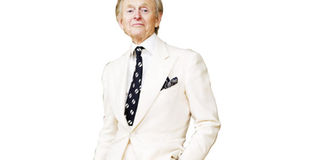Dressing a journalist

One of the most stylish man globally to date remains journalist and author Tom Wolfe. At 86, he still wears his bespoke white suits. PHOTO| FILE| NATION MEDIA GROUP
What you need to know:
- Years ago when South African magazine publishing powerhouse Media24 were still invested in Kenya, they insisted all staff had to grow themselves into authorities, brands and personalities.
- Editors had to dress like they run the show.
- Writers had to look like they walked into high profile offices every day, ready for exclusive invites round the clock.
Saw the most interesting articles last week. Journalists were barred from entering the Kakamega County Assembly for failing to observe the dress code. The formal dress code requires ties and a badge of identification.
This was not the first time journalists had a run-in with formal wear. In 2013 Nakuru Country issued a dress code they maintained had to be strictly adhered to by staff, MCAs and yes, journalists. MCAs had to wear suits and ties and ladies, trouser and skirt suits. Journalists were once again barred from covering the sessions. The Speaker, Ms Susan Kihika, was quoted as saying: “I do not see why journalists should be concerned. They too need to be smartly dressed. The wearing of a neck tie and being in a suit shows some level of seriousness.” After all, she added, this was business attire.
The Media Council of Kenya does not have any such thing as a dress code. Our code of conduct is far more concerned with the conduct and principles of journalism. This is hardly surprising. Media was built on the back of print journalism and when it comes to the press, they act and dress like back office staff. Invisible, powerful use of words to break barriers, open doors and minds but without having to address how they look. Radio journalists dress up better than print journalists and TV journalists stake their careers on appearance as much as their skill, if not more so. They are as memorable for how they look as they are for what they do.
Years ago when South African magazine publishing powerhouse Media24 were still invested in Kenya, they insisted all staff had to grow themselves into authorities, brands and personalities. Editors had to dress like they run the show. Writers had to look like they walked into high profile offices every day, ready for exclusive invites round the clock. To facilitate this they brought in an image consultant who spent two days showing us how to clean up and look like we worked at Vogue and GQ. Veteran male journalists formerly of newspaper persuasion flipped. In a fit of pique he explained to the blazer-complete-with-pocket-square-wearing Derek Bbanga that scruffy was always going to be in, nobody cared how he looked so long as he got the work done and the story in, and he will not change who he was to look any particular kind of way for any particular kind of reason. The ladies, meanwhile, held GIF-worthy expressions.
An event photographer once told me paparazzi don’t dress up. Except they do. Any behind the scenes red carpet images will show paparazzi have to be in black tie complete with identification or they will not be let in. Shabby journalists and with unstylish attitudes are not unique to Kenya. In 2006, Taipei Times had an article: “Is there a journalist dress code or does anything go?” In 2017 the head of Egypt’s Supreme Media Council declared jeans unacceptable when journalists attend events and formal interviews. He went as far as impose penalties. There is a slight allowance for journalists to “improve their appearance”. Egyptian journalists reacted exactly like my colleague, throwing arrest and killing of journalists and coverage of all the issues affecting their country that needed prioritising. In July 2017, Capitol Hill issued a strict no-sleeveless policy for women. A female journalist was offered a sweater to pass through hallways. Open-toed shoes are not allowed either and men must wear a suit jacket and a tie. They borrow “ties of shame” if they have none. The rules, their speaker said, are applicable as Speaker Kihika had said. All round inside the building. In 2014 a reporter wrote guidelines under #dresslikeajourno, saying press dress for “function over form”. Locally media houses create their own culture and dress code. There is no overall “this is how journalists must dress for duty”.
One of the most stylish man globally to date remains journalist and author Tom Wolfe. At 86, he still wears his bespoke white suits. Ironically, it was because he had no money and only white suits. He is known as brilliant and eccentric, considered both iconic and legendary in his own lifetime, partly because of his mind, partly his style. Moral of the story? Journalists are going to have to suck it up and get some style.




